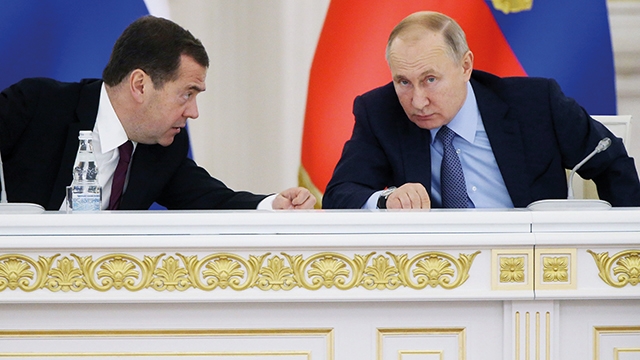Putin’s Constitutional Revolution in Russia – Tandem Government
Op-Ed
On Wednesday, during the annual state-of-the-nation address, one of several appearances before the Russian political elite, Russian President Vladimir Putin was expected to talk mostly about large programs for the improvement of the social situation in Russia, perhaps the most pressing issue for ordinary Russians. However, as it turned out, it was only a prelude to what came in the second half of his speech when he went on to propose major constitutional changes, thus effectively starting what has been anticipated for years: the power transition process for post-2024 Russia when Putin is expected to step down from the presidency.
As there is almost year and a half to the next parliamentary elections and four years to the next presidential elections, his announcement came sooner than expected. Nevertheless, the move to change the constitution was overall well received. Hints in the Russian media over the past year have been suggesting that there were important constitutional changes ahead. The timing and careful wording of various articles and statements pointed towards potential changes that could touch upon the power of the President of Russia and that of the State Duma.
One of the notable examples was Russia’s Speaker of the Duma, Vyacheslav Volodin, who in 2019 penned an article to commemorate the 25th anniversary of the Russian Constitution in which he discussed the need to increase the Duma's powers. The author suggested that it would be better if the organ participated more actively, even played a major role, in the formation of the Russian government.
The constitutional changes proposed by Putin on January 15 echo previous hints and set out to increase the State Duma’s role in the formation of the Russian government, namely the Russian PM will be chosen by the deputies and the President will have to approve the decision.
This, to a certain extent, is a revolutionary proposition. According to the 1993 Russian constitution, the country was ruled by an all-powerful president, the role of PM was diminished, as was that of the State Duma. Putin’s propositions are to change this model, which makes many think he will take on the PM’s position at the end of his presidency in 2024. Others suggest he will leave the presidency and take on an altogether different position.
What is clear for the moment is that Putin is unlikely to remain president after 2024. His speech signaled this scenario when he mentioned specific historical and cultural features which characterize the Russian statehood, thus ruling out a transition to a parliamentary model. He also suggested that the Russian President, following on from the constitutional changes, will still be a powerful figure, able to dismiss the PM and control the state’s armed forces, etc.
Putin could indeed move to the PM position. It is possible he is already preparing the checks and balances so that in the future PMs will not be easily sacked by the President. Though many believe he would not do this for a third time, as he will still be dependent on the President and State Duma, one should remember that Putin already served twice as PM, and this at a time when the position of PM was weak and constitutionally Putin was vulnerable. This did not change much, though, as much depended on personal authority – in 2012 Putin returned to the presidency unharmed by his time as Prime Minister. By increasing powers for the PM, Putin will be even safer than in 2008-2012 should he choose to stay in power beyond 2024.
These constitutional changes introduce an interesting development: a strong ruling tandem in Russia in the coming years: a strong president alongside a powerful PM. Perhaps the idea was first fabricated in 2008-2012 when Putin served as PM under Dmitry Medvedev. It is in a way an innovative system too as Russia, irrespective of various models of government (imperial, Soviet), has usually been ruled by a strong leader propped up by the Constitution.
Still, even with this meticulous preparation for constitutional changes, a mood of protest is likely to increase across Russia. In 2012, Putin’s return resulted in massive protests in Moscow, while in 2019, reportedly, tens of thousands protested in Moscow demanding fair elections.
It will also be much tougher for Putin to convince the ruling Russian elites that his presence will be successful. Many counterarguments exist, the most important of which is the decline of the Russian economy. Reform-driven economists want to see radical changes, while the government has already missed an opportune timing.
On the foreign policy front, the Kremlin’s failures in Ukraine stand out as most evident for the Russians. Many fundamental questions exist and the Russians, particularly the younger population, are unlikely to follow Putin’s decision to stay in power. Thus, large-scale protests will be seen countrywide.
In many ways, the prolongation of Putin’s rule is a consolidation of various internal and foreign policy problems which have accumulated since his coming to power in 2000. As time passes, momentum for reconsideration of his policies is bound to mount.
By Emil Avdaliani
Image source: Mikhail Svetlov / Getty Images












